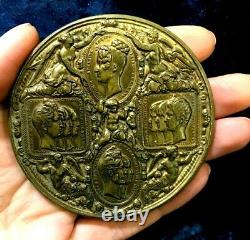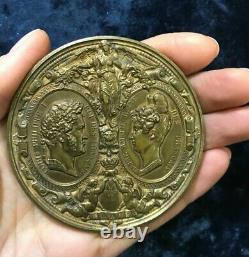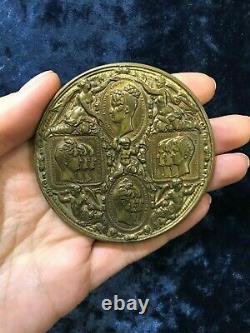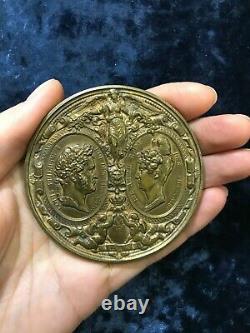1833 Louis-Philippe Marie-Amélie Madame Adélaïde Royal Family French medal





Médaille en bronze, visite de la Famille royale à la monnaie de Paris en 183Représentant Louis-Philippe Ier et Marie-Amélie/Deux médaillons encadrés dans un cartouche très orné, présentant les bustes en regard du roi et de la reine ; à gauche celui du roi, tête et col nus, de profil à droite avec la légende : LOUIS PHILIPPE I ROI DES FRANÇAIS ; à droite le buste de la reine, de profil à gauche, tête et col nus, en coiffure du temps, collier et double rang de perles au cou, avec la légende : MARIE AMELIE REINE DES FRANCAIS. Ces médaillons sont réunis au centre par une tête de lion, au-dessus de laquelle se dresse une femme ailée, debout de face, le torse nu, qui dépose un rameau de chêne et d'olivier sur le médaillon à l'effigie du roi et un bouquet de fleurs sur celui de la reine. Au-dessous de la tête du lion est un écusson surmonté de la couronne royale et chargé en cour des Tables de la loi où on lit en trois lignes : CHARTRE DE 1833.
Médaille dynastique pour la visite de la Monnaie. (6 October 1773 - 26 August 1850) was. He distinguished himself commanding troops during the. Over its decision to execute King. He fled to Switzerland in 1793 after being connected with a plot to restore France's monarchy.
Louis Philippe II, Duke of Orléans. (Philippe Égalité) fell under suspicion and was executed, and Louis Philippe remained in exile for 21 years until the.
He was proclaimed king in 1830 after his cousin. Was forced to abdicate by the. The reign of Louis Philippe is known as the. And was dominated by wealthy industrialists and bankers. He followed conservative policies, especially under the influence of French statesman. He also promoted friendship with Britain and sponsored colonial expansion, notably the. His popularity faded as economic conditions in France deteriorated in 1847, and he was forced to abdicate after the outbreak of the.He lived out his life in exile in the United Kingdom. His supporters were known as.
Who supported the main line of the House of Bourbon. In 1796, Louis Philippe supposedly fathered a child with.In 1808, Louis Philippe proposed to Princess Elizabeth. Daughter of King George III of the United Kingdom. His Catholicism and the opposition of her mother Queen Charlotte. Meant the Princess reluctantly declined the offer.
In 1809, Louis Philippe married Princess Maria Amalia of Naples and Sicily. Daughter of King Ferdinand IV of Naples. And Maria Carolina of Austria. The ceremony was celebrated in Palermo 25 November 1809.The marriage was considered controversial, because she was the niece of Marie Antoinette, while he was the son of Louis Philippe II, Duke of Orléans. Who was considered to have played a part in the execution of her aunt. Her mother was skeptical to the match for the same reason, but she had given her consent after he had convinced her that he was determined to compensate for the mistakes of his father, and after having agreed to answer all her questions regarding his father.
The Duke of Orleans in uniform as a Colonel-General of the Hussars. At the time of the Bourbon Restoration. Louis Philippe had reconciled the Orléans family with Louis XVIII in exile, and was once more to be found in the elaborate royal court.However, his resentment at the treatment of his family, the cadet branch of the House of Bourbon. Caused friction between him and Louis XVIII, and he openly sided with the liberal opposition.
Louis Philippe was on far friendlier terms with Louis XVIII's brother and successor, Charles X. Who acceded to the throne in 1824, and with whom he socialized. However, his opposition to the policies of Villèle.
And later of Jules de Polignac. Caused him to be viewed as a constant threat to the stability of Charles' government. This soon proved to be to his advantage. Louis-Philippe d'Orléans leaving the Palais-Royal to go to the city hall, 31 July 1830, two days after the July Revolution.King Louis-Philippe I taking the oath to keep the Charter of 1830 on 9 August 1830. In 1830, the July Revolution. Overthrew Charles X, who abdicated in favour of his 10-year-old grandson, Henri, Duke of Bordeaux. And, naming Louis Philippe Lieutenant général du royaume, charged him to announce to the popularly elected Chamber of Deputies.
His desire to have his grandson succeed him. Louis Philippe did not do this, in order to increase his own chances of succession. As a consequence, because the chamber was aware of Louis Philippe's liberal policies and of his popularity with the masses, they proclaimed Louis Philippe, who for eleven days had been acting as the regent. For his young cousin, as the new French king, displacing the senior branch of the House of Bourbon. Charles X and his family, including his grandson, went into exile in Britain.The young ex-king, the Duke of Bordeaux, who, in exile, took the title of comte de Chambord, later became the pretender. To the throne of France and was supported by the Legitimists. Louis-Philippe was sworn in as King Louis-Philippe I on 9 August 1830. Upon his accession to the throne, Louis Philippe assumed the title of King of the French - a title already adopted by Louis XVI.
In the short-lived Constitution of 1791. Linking the monarchy to a people.
Instead of a territory (as the previous designation King of France and of Navarre) was aimed at undercutting the legitimist claims of Charles X and his family. By an ordinance he signed on 13 August 1830. The new king defined the manner in which his children, as well as his "beloved" sister, would continue to bear the surname "d'Orléans" and the arms of Orléans, declared that his eldest son, as Prince Royal. (not Dauphin), would bear the title Duke of Orléans.
That the younger sons would continue to have their previous titles, and that his sister and daughters would only be styled Princesses of Orléans, not of France. His ascension to the title of King of the French was seen as a betrayal by Emperor Nicholas I of Russia. And it ended their friendship. In 1832, his daughter, Princess Louise-Marie. Married the first ruler of Belgium, Leopold I, King of the Belgians.Their children included Leopold II of Belgium. And Empress Carlota of Mexico. Maria Amalia of Naples and Sicily. Portrait by Louis Édouard Rioult.
Queen consort of the French. 9 August 1830 - 24 February 1848.26 April 1782 Caserta Palace. 24 March 1866 (aged 83) Claremont House. Ferdinand Philippe, Duke of Orléans. Louise, Queen of the Belgians.
Marie, Duchess Alexander of Württemberg. Princess Françoise Clémentine, Princess of Saxe-Coburg and Gotha.Maria Amalia Teresa di Borbone French: Marie-Amélie Thérèse de Bourbon-Siciles. Ferdinand I of the Two Sicilies. Maria Amalia of Naples and Sicily (Maria Amalia Teresa; 26 April 1782 - 24 March 1866) was a French queen by marriage to Louis Philippe I.
Maria Amalia (left) with her older sister Maria Luisa. Maria Amalia was born on 26 April 1782 at the Caserta Palace. She was the tenth of eighteen children of Ferdinand I of the Two Sicilies. As a young Italian princess, she was educated in the Catholic tradition, which she appears to have taken to heart.Maria Carolina, like her mother, Maria Theresa. Made an effort to be a part of her daughter's life, though she was cared for daily by her governess, Vicenza Rizzi.
As a child, Maria Amalia's mother and her aunt, Marie Antoinette, arranged for her engagement to Marie Antoinette's son, Louis Joseph, Dauphin of France. The future king of France. Her young fiance died in 1789. Maria Amalia faced chaos and upheaval from a young age. The death of her aunt Marie Antoinette. And her mother's subsequent dramatic actions emblazoned the event in her memory. During the outbreak of the French Revolution. In 1789, the Neapolitan court was not hostile to the movement. When the French monarchy was abolished and her aunt Marie Antoinette. Were executed, Maria Amelia's parents joined the First Coalition. Although peace was made with France in 1796, by 1798 conflict again erupted and the royal family fled to the Kingdom of Sicily. On 21 December 1798 aboard HMS Vanguard.Vessel protected by two Neapolitan warships. Maria Amalia spent the years 1800 to 1802 with her mother in Austria.
After the invasion of Naples by Napoleon in 1806, the royal family was once more forced to flee to Sicily, where they again settled in Palermo under the protection of British troops. While in exile, Maria Amalia encountered her future husband, Louis Philippe d'Orléans. Also forced from his home in France. Due to political complications of the French Revolution and the rise of Napoleon. Louis-Philippe's father, the previous Duke of Orléans. Had been guillotined during the French Revolution. Though he had advocated it in the early years. The two were married in 1809, three years after they met in Italy, whereupon Marie-Amelie became Duchess of Orléans. The marriage was considered controversial, because she was the niece of Marie Antoinette, while he was the son of a man. During the first years of her marriage, Marie-Amelie and Louis Philippe lived under British protection in Palermo, in a palace given to them by her father, the Palazzo Orléans.Marie-Amelie went to France with her new husband in 1814, where she attempted to make a home with her growing family, but with Napoleon's brief return, she was forced to flee yet again. The family was given permission to return to France again in 1817. During the Orléans' time in France prior to Louis-Philippe's accession, the family lived in the Palais-Royal.
Which had been the home of her father-in-law, Louis Philippe II, Duke of Orléans. During their tenure as Duke and Duchess of Orléans, her spouse made Palais-Royal a center of high society in Paris when the aristocracy found the royal court, which was organized according to revived l'ancien regime-etiquette, too stiff. However, it was rather her sister-in-law Madame Adelaide. Who was regarded the hostess at Palais-Royal, while Marie-Amelie was described as dignified but silent and withdrawn. In 1825, the Duke and Duchess met with her sister and brother-in-law, the King and Queen of Sardinia in Chambéry, and in May 1830, the hosted her brother and sister-in-law, the King and Queen of the Two Sicilies, at Palais-Royal. Maria Amalia, by Louis Hersent. In 1830, following what is known as the July Revolution. Louis-Philippe became king of France, with Maria Amalia as queen of the July Monarchy.Maria Amalia did not approve of Louis-Philippe's acceptance of the crown and reportedly described it as a catastrophe. When tumult followed the publication of the Ordinances in 1830 and erupted in the July revolution in Paris, the Orléans family was at the country estate Neuilly.
Her sister in-law, Adélaïde, convinced Louis-Philippe that the moment was right for him to place himself as the leader of the opposition against the absolute monarchy of Charles X, and present himself as the candidate of a constitutional monarchy, in between the unpopular absolute monarchy and the republicanism. In this, she defeated the view of her Maria Amalia, who was loyal to the reigning older branch. When rumors arrived that the royalists were going to arrest Louis-Philippe, he evacuated to Raincy.And the children were sent to Villers-Cotterêts. But Adélaïde and Maria Amalia remained at Neuilly. When a delegation reached Neuilly and offered Louis-Philippe the crown, Maria Amalia refused the offer on behalf of herself and her spouse, reproaching Ary Scheffer. For insulting them by having made it.
Adélaïde, however, accepted it with the argument that her brother would do anything to prevent the country he loved from anarchy. Accepted the answer of Adélaïde rather than the one from Maria Amalia with the words: "Madame, you have given the crown to your family".
After this, several other visits followed from people asking Louis-Philippe to accept the crown: to all, Maria Amalia answered that Louis-Philippe was an honest man and thus could not do it, while Adélaïde contradicted her by stating, that the offer should be made to Louis-Philippe by the chamber of deputies; and if he should hesitate, she would herself go to Paris and accept the crown for him. Soon after, the Chamber of Deputies called Louis-Philippe to Paris to formally present him their offer. It has been estimated that he accepted the crown largely because of Adélaïde. Portrait of María Amelia de Borbón-Dos Sicilias, by Franz Xaver Winterhalter.
When the news arrived that Louis-Philippe had accepted the crown, Maria Amalia reportedly cried and sobbed: What a catastrophe! They will call my husband an usurper! She refused to return to Paris with her children in an open state carriage, as this would give an impression of triumph.
When she did arrive to the Palais-Royal, which was at that time wide open to the public, it was noticed that she looked as if she had been crying, which attracted attention. She and her sister-in-law visited those who had been wounded during the revolution, and supported them financially.
Maria Amalia was to say that she could see no advantages of the crown, only the destruction of a peaceful family life and an insecurity for the lives of her family. At 6 August 1830, she and her sister-in-law was present at the tribune on the ceremony at the chambers when Louis-Philippe were declared King of the French. She herself was never honored with any form of official ceremony, though she was automatically given the honorary title Queen of the French. Maria Amalia did not play an active role in politics and in fact made a concerted effort to remove herself from it. In 1832, after the failed coup of Marie-Caroline de Bourbon-Sicile, duchess de Berry. Marie-Caroline appealed to her from her prison at Blaye, as did one of Marie-Caroline's followers, Mesnard; however Maria Amalia refused to even receive the petition of the first nor to promise anything to the second, despite being personally attached to the Duchess de Berry.It was with his sister rather than with his wife that the King discussed state affairs. As Queen, Maria Amalia became foremost known for her simple personal life style and her charity. For political reasons, King Louis-Philippe did not wish to have any representation or court life of the more elaborate kind but, rather wished to give the impression of his family living a life of the burgher class, and during her tenure as Queen, the royal court was relatively subdued to its outward appearance.
The court etiquette at the Tuileries was therefore simplified, and the royal family lived a life which was to be modeled after the ideal life of a wealthy burgher class family of the time, with few state occasions, though they did regularly host smaller gala dinners for the representatives of the people. This domestic life did suit Maria Amalia, who was already devoted to this life style. The household included her lady-in-waiting, the Marquise de Dolomieu.After having heard mass and received private audiences, she worked with her secretaries receiving, personally reading and attending to petitions from the poor. Reportedly, Maria Amalia received a personal allowance of 500.000 franc, and spent 400.000 franc of that sum on charity.
In one instance, she responded to a request from French missionary sister Saint Mother Theodore Guerin. Of the Sisters of Providence of Saint Mary-of-the-Woods.By saying, Ah, yes, sisters, let us save souls! She gave Guerin and her fellow Sister of Providence Mary Cecilia Bailly. Funds for their schools in the United States, as well as covered their travel expenses. Reportedly, however, she did give contributions to the needing regardless of their political or religious convictions. In 1843, she hosted British Queen Victoria.
At the Château d'Eu. She did not, however, follow Louis-Philippe on his visit to England in 1844. While Maria Amalia had accepted the crown unwillingly, she regarded it her duty to keep it after it had once been given to her by God. During the Revolution of 1848. Maria Amalia made an attempt to get Louis-Philippe to take control of the troops, rally the National Guard, subdue the riots on the streets and defend his crown with his life. Reportedly, he did not answer her, but only asked her to trust his judgement. When a mob marched toward the Tuileries, Louis Philippe was convinced by his ministers to flee, and he signed his abdication in favor of his grandson against the consent of Maria Amalia. When the family left the palace, Maria Amalia reportedly turned to minister Thiers and commented: Ah Monsieur, you were not worthy of such a good king! The family left under somewhat chaotic circumstances, and Maria Amalia reportedly fainted and had to be lifted into her carriage. The couple were accompanied by their son Antoine, Duke of Montpensier.Their daughter-in-law the Duchess of Nemours. And her spouse, as well as six grandchildren. Their eldest son's widow the Duchess of Orléans. And her sons were left at the palace in the company of their son the Duke of Nemours to fight for the right to the crown of their grandson, the Count of Paris. The family left Paris for Saint-Cloud.
And from there to Dreux. Where they parted and made their way to England in different groups. Maria Amalia and Louis Philippe lived for a while in the cottage of a friend in Honfleur. Before they left in secret by Havre to Newhaven in England. In England, Louis Philippe and Maria Amalia were well received by Queen Victoria, who let them live in Claremont House.
Louis Philippe died two years later. After the death of her husband, Maria Amalia continued to live in England where she attended daily Mass and was well known to Queen Victoria. She spent her remaining years living a private family life, and was joined by most of her children with the exception of the Duke of Montpensier.
Maria Amalia regarded the elder branch of the Bourbon to have superior right to the French throne, and she supported her son the Duke of Nemours when he reconciled with the head of the elder Bourbon line, Henri, Count of Chambord. On behalf of the Orléans line. At her death, she also asked to be called Duchess of Orléans on her grave stone rather than Queen of the French. Maria Amalia died on 24 March 1866, aged 83. After her death, the dress she had kept since 1848 when her husband had left France was put on her, according to her last wishes.
This item is in the category "Coins & Paper Money\Exonumia\Medals". The seller is "top-art-medals" and is located in this country: IL. This item can be shipped worldwide.

